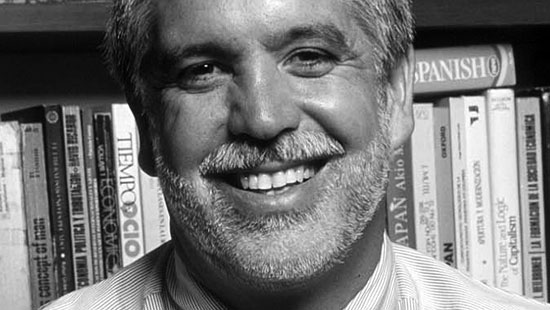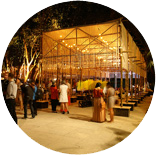Enrique Peñalosa

Enrique Peñalosa is an influential thinker in the design of livable cities, with a particular interest in the relationship between urban design and sustainability, mobility, equity, public space, and well-being. As mayor of Bogotá, Colombia, between 1998 and 2000, Peñalosa implemented profound changes—many of them the first of their kind in the Americas—that transformed the seven-million-inhabitant city.
In addition to vast improvements to the city’s slums and the construction of schools, nurseries, and libraries, he restricted car use, created a 300-kilometer network of bicycle paths, and radically improved pedestrian facilities. More than 100 kilometers of pedestrian-only streets and greenways were created, including Porvenir Promenade, a 24-kilometer pedestrian-and-bicycle-only street through the city’s poorest neighborhoods, and Juan Amarillo Greenway, a pedestrian street that connects the richest and poorest neighborhoods of the capital. Inspired by Curitiba, Brazil, he created the TransMilenio bus system, which has served as a model for many other cities and is now considered the best bus system in the world.
Peñalosa has lectured at universities throughout the world, as well as at environmental, urban, and managerial forums. His work and ideas, as well as his articles, have been featured in publications in many countries. He holds a bachelor of arts degree in economics and history from Duke University, a master’s degree in government from the Institute Internationale d’Administration Public (IIAP) in Paris, and a DESS in public administration from the Université de Paris II. He was a visiting scholar at New York University for three years and has taught at several Colombian universities. He is currently an urban vision and sustainability strategy consultant, working with local, regional, and national governments as well as other organizations all over the world, and is president of the board of directors of the Institute for Transportation and Development Policy (ITDP).
Vision Statement on Confronting Comfort
Today the ideal environment for a whale or mountain gorilla is clearer to most of us than is the ideal environment for a child. If we ask people in the street what their ideal home is, they will likely tell us in a very detailed manner where it would be, the size, whether it would have carpet or wood floors, and other details. But if we ask instead about their ideal city, it is likely that we will not get much information. Yet most people spend more waking hours out of their homes than inside them. The quality of the city we live in is thus at least as important as our home for our well-being.
Beyond survival needs, we have “happiness needs,” or “well-being needs,” that a good city would help fulfill: we need to walk; to see and be with people; to feel included and not inferior; to have contact with nature (such as trees or water), beauty, art, and quality architecture.
If we tell a child anywhere in the world: “Watch out, a car!!” he or she will jump in terror, with good reason. A car is no minor threat; it can kill. And indeed cars kill tens of thousands of children annually. Astonishingly, we have come to think of this as normal. Yet is that the best we can do after 5,000 years of urban history? For millennia, cities faced enormous sanitary problems derived from poor water and sewage provision, overcrowding, and poverty. But all city streets were for people and a few horses. People could be hit by a horse carriage but would rarely die as a result.
Creating a city that is very friendly to cars conflicts with maintaining an environment that is friendly to people. The 20th century will be remembered as an unfortunate one for urban history, as we created habitats far more conducive to the movement of motor vehicles than to human well-being.
If car use is to be limited, cities must have quality public transport. Low-cost, high-frequency transit requires density. It is widely agreed today that it is desirable to have compact, dense cities, for environmental and livability reasons. Yet density can be very different in Manhattan and in Tokyo.
It is possible to create better cities. It is possible to provide what people have sought in the suburbs in much higher-density environments: not only good schools, which can exist anywhere, but also green spaces and safe streets where children can ride their bicycles. This is easy to accomplish in growing cities that will occupy large tracts of green fields over the next few decades, but it is possible everywhere. Better cities could have hundreds of kilometers of networked paths, comprising greenways crisscrossing the city in many directions; roads dedicated to bus use only, lined with quality sidewalks and bicycle paths; and tree-lined pedestrian-and-bicycle-only promenades, which could serve as bicycle highways—safe, fast, and pleasant to ride—as well as places to promenade or sit and read a newspaper without the noise and danger of cars nearby.
If public transport is truly to have priority over private cars, it is cars that should go underground, and fast, quality public-transport alternatives should be found on the surface, with natural sunlight and views of the city. Every large road should have lanes exclusively for buses.
It is possible to envision cities where shopping malls do not replace public space as meeting places for people; where all citizens are truly equal before the law, and where a bus with 60 passengers has a right to 60 times more road space than a car with one; where a bicycle is as respected as a car, and protective bicycle infrastructure is found everywhere; where public good truly prevails over private interest and there are no private waterfronts; and where there is equality of quality of life for all children, and all of them have the same access to swimming pools, tennis courts, and music lessons, regardless of their income. Cities for people … an apparently obvious idea but in practice unfortunately not so.
—Enrique Peñalosa
Photo: courtesy Enrique Peñalosa

